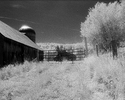Matt5791
Member
I have not been into processing and printing my own B&W for very long, but one of the things that I have noticed is that some of my prints seem a little lifeless - I mean this in that I am only getting the middle tones - no real sharp blacks or whites, but especially blacks.
I am wondering whether this could be put down to chemical temperature because I think that, because my attic is so cold at the moment, no sooner have I put the chemicals into the trays the temperature is going down well below 20 degrees. (I have a Photax tray warmer on its way to me)
Could it also be anything to do with the developer I have been using (Paterson Acugrade) although I think this might be less likely.
I know that some of the prints have been worsened because I have given the paper too much exposure, so mabe I should try less exposure and raise the contrast?
Thanks for any ideas,
Matt
I am wondering whether this could be put down to chemical temperature because I think that, because my attic is so cold at the moment, no sooner have I put the chemicals into the trays the temperature is going down well below 20 degrees. (I have a Photax tray warmer on its way to me)
Could it also be anything to do with the developer I have been using (Paterson Acugrade) although I think this might be less likely.
I know that some of the prints have been worsened because I have given the paper too much exposure, so mabe I should try less exposure and raise the contrast?
Thanks for any ideas,
Matt





